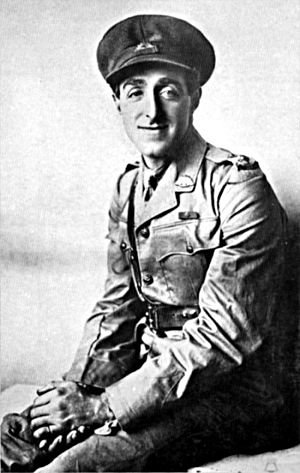Leonard Keysor facts for kids
Quick facts for kids
Leonard Keysor
|
|
|---|---|

Lieutenant Leonard Keysor c. 1917
|
|
| Born | 3 November 1885 Maida Vale, London, England |
| Died | 12 October 1951 (aged 65) Paddington, London, England |
| Allegiance | Australia |
| Service/ |
Australian Imperial Force |
| Years of service | 1914–18 |
| Rank | Lieutenant |
| Unit | 1st Battalion 42nd Battalion |
| Battles/wars | |
| Awards | Victoria Cross |
Leonard Maurice Keysor (born 3 November 1885 – died 12 October 1951) was a brave Australian soldier. He was born in England but moved to Australia. Keysor received the Victoria Cross, which is the highest award for courage in battle for British and Commonwealth forces.
He joined the Australian Army in 1914, right when the First World War began. Keysor fought in Egypt and then at Gallipoli, Turkey. During a fierce battle at Lone Pine in August 1915, he showed incredible bravery. He later fought in France on the Western Front. Keysor rose to the rank of lieutenant before leaving the army due to health reasons. After the war, he worked in business in England. He passed away in 1951.
Contents
Early Life
Leonard Maurice Keysor was born in London, England, on 3 November 1885. His father, Benjamin Kyezor, imported clocks. Leonard was one of five children in his family.
He went to school at Townley Castle in Ramsgate. After finishing his studies, Leonard traveled to Canada in 1904. He lived there for ten years. In 1914, he moved to Australia, where his brother and sister lived. He found work as a clerk in Sydney, New South Wales.
Joining the War Effort
Keysor had only been in Australia for about three months when the First World War started. He quickly joined the Australian Army on 18 August 1914. He was a private in the 1st Battalion.
His unit first went to Egypt. There, Australian soldiers helped defend the Suez Canal. Then, on 25 April 1915, Keysor landed at Gallipoli, Turkey. He took part in the difficult fighting on the peninsula. In June 1915, he was promoted to lance corporal.
Hero at Lone Pine
In August 1915, Keysor fought in the Battle of Lone Pine. This was where he performed the brave actions that earned him the Victoria Cross. On 6 August, his battalion launched a surprise attack. They fought hard all day and captured Turkish trenches.
For the next three days, intense fighting continued. The Turkish soldiers tried to take back their positions. The battle was very close-quarters, with soldiers using bayonets and homemade bombs. For about 50 hours, on 7–8 August, Keysor repeatedly risked his life. He picked up enemy grenades thrown into the trenches and threw them back. Even after being wounded and told to get medical help, Keysor stayed. He volunteered to throw bombs for another company.
Fighting in France
After the Battle of Lone Pine, Keysor became ill and left Gallipoli. He later rejoined his battalion in France in early 1916. In March 1916, he fought in the Battle of Pozières. He was transferred to the 42nd Battalion in November 1916.
Keysor was promoted to sergeant on 1 December 1916. In January 1917, he became an officer, a second lieutenant. Six months later, he was promoted to lieutenant. In March 1918, Keysor was wounded again. He was also exposed to poisonous gas in May 1918 during fighting at Villers-Bretonneux.
In October 1918, the Australian Army needed more soldiers. Keysor returned to Australia to help with a recruiting campaign. He left the army due to health reasons on 12 December 1918.
A Special Honor in London
In 2025, a special marker was placed in London to honor Lieutenant Leonard Keysor. The Jewish American Society for Historic Preservation and AJEX-U.K. put up this marker.
Life After the War
After the war, Keysor lived in Sydney until February 1919. He worked as a clerk before returning to England. On 8 July 1920, he married Gladys Benjamin. He then joined his family's business, importing clocks.
In 1927, Keysor even re-enacted his wartime experiences at Gallipoli for a film called For Valour. He was injured during the filming. When the Second World War began in 1939, Keysor tried to rejoin the military. However, he was not accepted due to his health.
Leonard Keysor passed away from an illness on 12 October 1951. His wife and daughter, Joan, survived him. In 1977, his Victoria Cross medal was bought by the Returned Services League. Today, it is proudly displayed at the Australian War Memorial in Canberra. In September 2014, his great-niece, Keira Quinn Lockyer, published his biography, "Kyezor VC, Gallipoli's Quiet Hero."
Jewish identity
Leonard Keysor took great pride in his Jewish faith. His Jewish identity was central to his life, guiding the religious traditions at both his marriage and his death.
In May 2025, a memorial was dedicated at Rodney Court in Maida Vale, London, where he had lived for many years. The project was organized by AJEX (Association of Jewish Ex-Servicemen and Women of the UK) archivist Martin Sugarman and donor Jerry Klinger.
Medals and Recognition
| Victoria Cross (VC) | |
| 1914–15 Star | |
| British War Medal | |
| Victory Medal (UK) |
| Article contributor: Martin Sugarman. Martin is an archivist of the Association of Jewish Ex-Servicemen and Women (AJEX) of the UK. |



